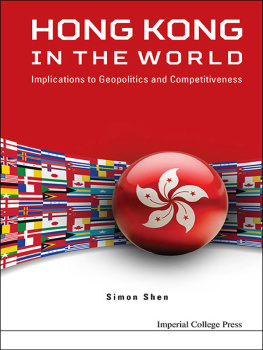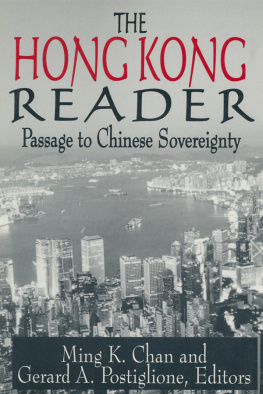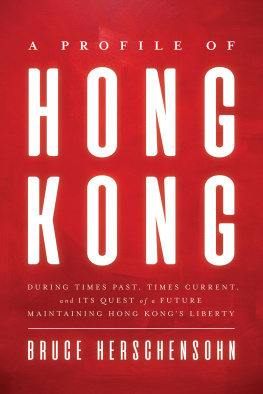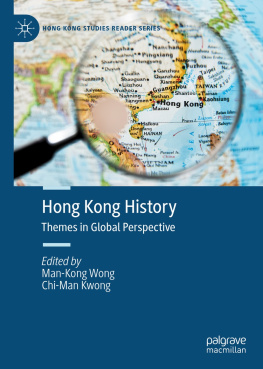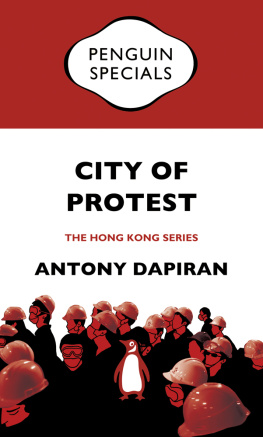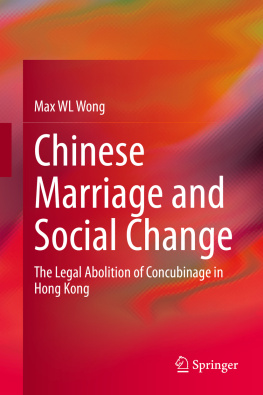Chinese Adolescents in Britain and Hong Kong
Identity and aspirations
GAJENDRA VERMA
University of Manchester
YIU MAN CHAN
University of Manchester
CHRISTOPHER BAGLEY
University of Southampton
SYLVIA SHAM
Manchester Metropolitan University
DOUGLAS DARBY
University of Manchester
DEREK WOODROW
Manchester Metropolitan Universtiy
GEORGE SKINNER
University of Manchester
First published 1999 by Ashgate Publishing
Reissued 2018 by Routledge
2 Park Square, Milton Park, Abingdon, Oxon, OX14 4RN
711 Third Avenue, New York, NY 10017
Routledge is an imprint of the Taylor & Francis Group, an informa business
Copyright Gajendra Verma, Yiu Man Chan, Christopher Bagley, Sylvia Sham, Douglas Darby, Derek Woodrow and George Skinner 1999
All rights reserved. No part of this book may be reprinted or reproduced or utilised in any form or by any electronic, mechanical, or other means, now known or hereafter invented, including photocopying and recording, or in any information storage or retrieval system, without permission in writing from the publishers.
Notice:
Product or corporate names may be trademarks or registered trademarks, and are used only for identification and explanation without intent to infringe.
Publishers Note
The publisher has gone to great lengths to ensure the quality of this reprint but points out that some imperfections in the original copies may be apparent.
Disclaimer
The publisher has made every effort to trace copyright holders and welcomes correspondence from those they have been unable to contact.
A Library of Congress record exists under LC control number: 99072979
ISBN 13: 978-1-138-61822-0 (hbk)
ISBN 13: 978-0-429-46128-6 (ebk)
Contents
Pride of place in these acknowledgements must go to the Trustees of the Leverhulme Trust who showed their faith in us in the most practical possible way: by generously providing the grant which made this research possible. Not for the first time, we express our gratitude to them.
Secondly, we would like to be able to thank all those young people who completed our questionnaires and agreed to be interviewed, here in Britain and in Hong Kong. As we thank them, we would also wish to express our appreciation to the schools and other institutions who kindly assisted us in gaining access to them.
We are also grateful for the help received from many people who contributed in a variety of ways to the success of the research project. Among these it is a pleasure to include Mr Peter Ma (Hong Kong Government Office), Rev. Dr J. Tsang for their helpful suggestions, Mr George Skinner who was involved in planning the original research, and Dr A.R. Neesham who did the final proofreading of the manuscript.
The research was conceived and directed by Gajendra Verma. Data on Chinese pupils were collected by Yiu Man Chan and Sylvia Sham, and parts of their doctoral theses are incorporated in this volume. Data collection and interviewing of European British students was undertaken by Douglas Darby, who was also responsible for writing parts of the text. Further data analysis and most of the writing were undertaken by Douglas Darby and Chris Bagley, who were also responsible for the final text editing.
Professor Gajendra K. Verma is Sarah Fielden Professor of Education at the University of Manchester.
Dr Yiu Man Chan was formerly Research Associate, School of Education, University of Manchester, and is now doing research in Hong Kong.
Professor Christopher Bagley, formerly of the City University of Hong Kong, is Professor of Social Work Studies, University of Southampton.
Dr Sylvia Sham is Research Associate, School of Education, Manchester Metropolitan University.
Mr Douglas Darby is Research Associate, School of Education, University of Manchester.
Professor Derek Woodrow is Professor of Education at Manchester Metropolitan University.
Mr George Skinner is a Lecturer in Education at the University of Manchester.
Introduction
The subject of a study has no objective existence. Its formulation grows from the interplay of the curiosity of the researcher, or researchers, and some aspect of the observed world about them. In this chapter we briefly outline the concerns which led us to attempt this study, describe how it was that its foci were established and how its general shape emerged.
In 1985 the Home Affairs Committee observed that:
remarkably little research has been carried out into the Chinese community, and the lack of reliable information extends even to its size and distribution (HAC, 1985).
Since that time there have been some educational studies of Chinese children and adolescents in Britain, but much more needs to be learned about how these children are experiencing life in Britain.
The 1991 Census, and the 1994 census of ethnic minorities have at least provided some background information. It is now known that there are about 200,000 people of Chinese ethnic origin living in Britain. Compared with other, more visible minority groups it is a not inconsiderable number. To put the number of Chinese people in Britain in perspective, it is almost identical to the Bangladeshi population and approximately one third the size of the Pakistani or Afro-Caribbean communities. In the next chapter, we give an account of the way the Chinese community in Britain grew between 1851 and 1991. At this stage we point to the two crucial differences between the Chinese community and those formed by settlers from the New Commonwealth and Pakistan (NCWP). These can be summarised in a few words: time and patterns of settlement.
Those arriving from NCWP countries, for reasons both complex and varied from one group to another, tended to form relatively compact settlements in well defined areas of Britains cities. This allied to their visibility, made them a focus of interest from neighbouring indigenous populations, Local Authorities, and researchers, not least because of the racism which these visible minorities were subject to. The Chinese community was by contrast, diffused throughout Britain so that, with the exception of London, Manchester and Liverpool no immediately recognisable Chinese districts existed. Even in those cities, the Chinese districts were concerned largely with businesses and social activities: few Chinese people actually lived in these China Towns.
Chinese men first started to settle, though not necessarily permanently, in the very early years of the nineteenth century and their numbers grew undramatically but steadily until, within the last 30 years and ending with the Commonwealth Immigration Act 1971 there was a marked acceleration in their arrival. This contrasts with the main process of settlement by NCWP migrants who arrived in larger numbers and in definable waves, over relatively short periods of time between 1950 and the 1970s. There was of course a significant African population in Britain during late Tudor times and again in the eighteenth and early nineteenth centuries. However, this nineteenth century African population was wholly absorbed into the general British European1 working class population through intermarriage.


